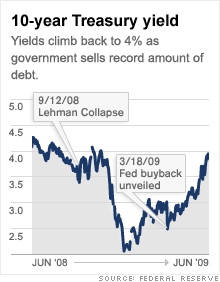10-year yield at 4% snarls recovery
Treasury yields are soaring. Mortgage rates are following. And the spike in interest rates threatens to upset the recovery party.

NEW YORK (CNNMoney.com) -- The 10-year Treasury yield soared to 4% for the second day in a row Thursday - before backing off later in the session -- heightening inflation fears and threatening to upset the nascent signs of an economic recovery.
Just six months ago, the yield on the 10-year note hovered around the 2% level, as investors opted to park money in government-backed debt rather than higher risk equities.
The bond market typically takes a back seat to the stock market, which offers higher rewards but also higher risk. As the economy slogged through the recession, investors have remained cautious and plugged into bonds.
Prior to Wednesday, the benchmark yield had not reached 4% since mid-October. But Wall Street's tectonic plates have started to shift.
The Dow Jones industrial average has surged 30% since hitting its 12-year low on March 9. Investors have been shrugging off bad economic news and seeing 'less bad' news as good news. As investors grow more optimistic about the "green shoots" of recovery, the bunker trade into the Treasury market has waned.
And historically, a 10-year yield at 4% is low. "Getting back over 4% is just one step in the right direction," said said William Larkin, portfolio manager at Cabot Money Management. "It is a sign that the economy is recovering and that people are starting to look at the other side."
The sharp drop off in debt prices is also a result of the massive amount of supply hitting the market. The government has been spending at a breakneck pace and has been selling an unprecedented amount of debt to finance its rescue efforts.
Housing. Rising interest rates have been pulling the rug out from a housing recovery.
The 30-year fixed mortgage rate moves in tandem with the benchmark 10-year Treasury yield, which has been on a tear. Mortgage rates hit 5.95% last week, according to a Bankrate.com's most recent national survey.
To try to keep a cap on mortgage rates, the Federal Reserve unveiled a program in mid-March to buy back $300 billion of its own debt. The so-called quantitative easing program was launched to jolt the Treasury market with demand, boost prices. The program worked for a while: Mortgage rates fell and refinancings surged.
But the benefits of the Fed's program were short-lived. And the debt buyback program is beginning to look a lot like the government using a soup ladle to keep a river from overflowing its banks.
Just this week, the government had three auctions lined up to sell $65 billion in debt: $35 billion of 3-year notes were sold Tuesday, $19 billion in a reopening of the 10-year note was sold Wednesday and $11 billion in the reopening of a 30-year bond hit the block Thursday.
Waning support. Other countries have started to doubt the creditworthiness of the U.S. Russia and China have both indicated that they are concerned about the unsustainable pace of spending. Russia said Wednesday it would consider shifting assets to other safe havens, like International Monetary Fund bonds.
"Longer term, the concern over foreign interest is a wake up call to Congress and the president," said Nick Kalivas, vice president of financial research at MF Global, in a daily research note. "The idea that the IMF bond is getting attention is a sign of investor worry over the U.S. fiscal situation."
What's next? With inflation fears rising and an economy still breathing on the lifeline of the government, the future of the bond market is murky. Some investors are looking for the Fed to try to increase its commitment to the debt buyback program. The Federal Open Market Committee is slated to meet June 23 and 24.
"There are some people speculating that they will expand their Treasury buyback program," said Craig Ziegler, managing director of Broadpoint Securities Group. "But I just don't know how much that helps when you are still issuing $150 billion in Treasurys in a month, not including bills."
Going forward, Larkin expects there will be more conversations about being fiscally conservative. When the rhetoric changes, that will help other foreign central banks feel more confident in U.S. debt, he said.
While Larkin does not expect the Fed to hike rates any time soon, he does expect the Fed to use aggressive language in coming statements to hint to the market that a rate hike is coming. "They are going to try to change the expectation so people can get used to the change."
Debt prices. Bond prices had been lower early in the day, sending yields soaring, but prices rallied into the 30-year bond auction. After a healthy auction, with nearly $30 billion bid for $11 billion in debt sold, the longbond led a charge forward, adding to earlier gains.
The 30-year bond rallied 1-29/32 to 92-22/32, and its yield fell to 4.25%. Earlier in the session, the long bond yield reached 4.83%.
The benchmark 10-year note rose 21/32 to 93-31/32, and its yield dipped to 3.86%. Earlier in the session, the benchmark Treasury touched 4%. Bond prices and yields move in opposite directions.
The 2-year note rose 3/32 to 99-6/32 and its yield dipped to 1.33%. The yield on the 3-month note held steady at 0.18%.
Lending rates. One key bank-to-bank rate continued to move lower. The 3-month Libor edged to 0.63% from 0.64% the day prior, according to Bloomberg.com.
The overnight Libor rate held steady at 0.26%.
Libor, the London Interbank Offered Rate, is a daily average of rates that 16 different banks charge each other to lend money. The closely-watched benchmark is used to calculate adjustable-rate mortgages. More than $350 trillion in assets are tied to Libor. ![]()

